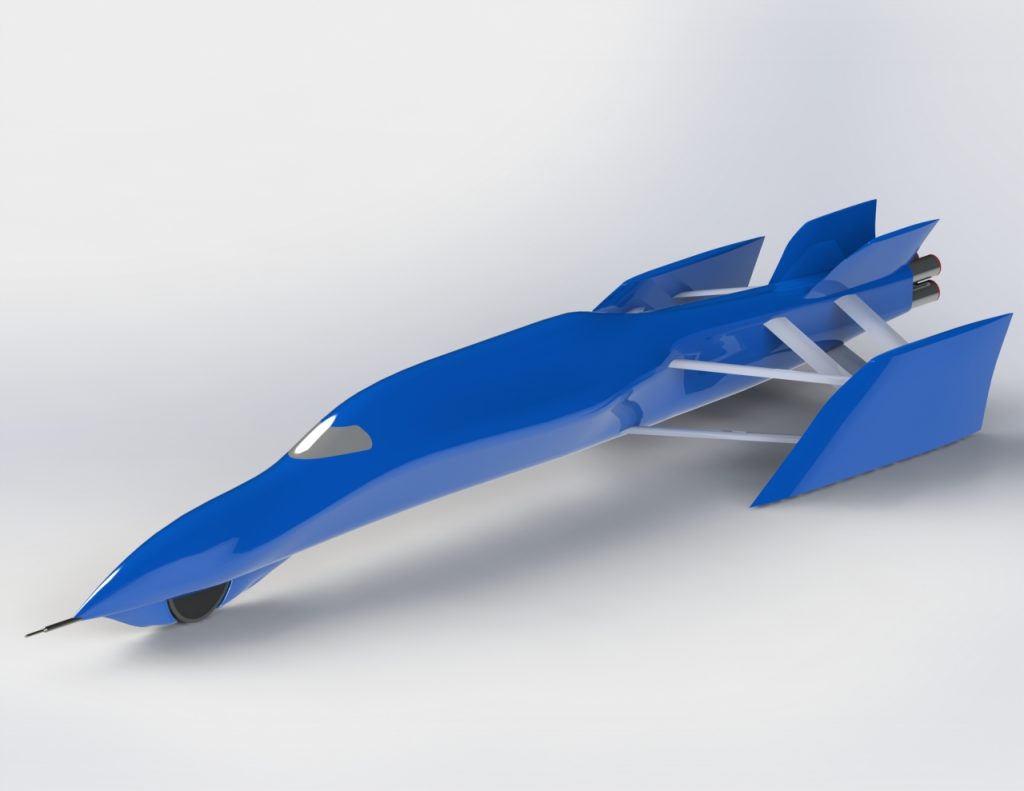NORWALK, OH — It’s a big world, but not even Earth offers many places for 500-miles-per-hour land speed racing.
Outside of the famed Bonneville Salt Flats in Utah, only south Australia’s Lake Gairdner and Bolivia’s Salar de Uyuni provide sanctioned salt flats racing. That’s it.
So what’s a guy with a 500-mph fighter jet-looking race car to do for testing and tuning before attempting to break several land speed records at Bonneville’s Speed Week slated for August 13-19?
We had the opportunity to ask Rob Freyvogel that very question when we bumped into him at Super Summit at Summit Motorsports Park, where he was displaying his Carbinite LSR Streamliner (which we wrote about in July last year). His answer made us giddy.
You make your own.
Using Google Earth (seriously), Freyvogel, who lives in Butler, PA scouted potential locations out west for running his Carbinite LSR Streamliner REALLY fast without destroying the car and/or dying. He found three he believed might work, then flew to Las Vegas, NV with his wife to check them out in-person and found a 7.2-mile stretch of super-flat public land covered in dirt which he said is legitimately flatter than the Bonneville Salt Flats.
Other than the wild donkeys running around (again, seriously) it was perfect.
Freyvogel and his land speed race team have dubbed the location “Area 52,” because: A. It’s in Nevada, like the infamous Area 51 U.S. military base, B. Best. Name. Ever. and C. He’s keeping the location a secret, so unless you’re a skilled donkey hunter, you’re probably not finding it.
They got the streamliner out to “Area 52” last September where Freyvogel set a new personal speed record of 360 mph, before the cockpit filled with dust, completely blinding him.
“I’m going: I don’t think there’s anything to hit, but this doesn’t feel right,” he said, sitting behind the SMP grandstand where even among a huge group of head-turning, eye-catching vehicles, the streamliner catches the most eyes and turns the most heads.
In land speed racing, horsepower plays second fiddle to optimized aerodynamics and drag reduction.
“Basically, you’re trying to fly an airplane on the ground,” Freyvogel said.
The Carbinite LSR streamliner is powered by a twin-turbo, fuel-injected 540 cubic-inch big block Chevy engine that makes about 2,600 horsepower at 30 pounds of boost. When all is said and done, Freyvogel and his team expect to eclipse the 500-mph mark and be certified as the world’s fastest wheel-driven car, anywhere, ever.
After the Southern California Timing Association canceled last year’s Speed Week due to flooding and unsafe conditions at the Bonneville Salt Flats, Freyvogel and his team are chomping at the bit to see what their race car is capable of.
The streamliner weighs 4,060 pounds when it’s full of fuel and water, Freyvogel said. It rides on custom-made Mickey Thompson 30 x 9 Bonneville Special tires (with about 90-100 lbs. of air pressure) in the back (which grow about four inches during a high-speed run), and two inline solid aluminum wheels in the front.
Freyvogel said the car gets smoother and more stable as it speeds up, and that land speed racing is all about design and engineering.
“Anyone can drive it,” he said. “People always care about who drives it, but that’s nothing. It’s easy to keep straight.”
The crew is planning to dyno the streamliner engine before heading back to “Area 52” this month for a final run before Bonneville, where we’re rooting for them to put their names in the land speed record books.
More Than a Record Chase
In addition to being the fastest wheel-driven car on the planet, Freyvogel, his race team, and the crew at Renfrew, PA-based Carbinite Metal Coatings are also committed to education and inspiring the next generation of manufacturing innovators, mechanics, and automotive enthusiasts.
While kids 50 years ago were often interested in building things, pursuing manufacturing careers, and spending weekends with their friends at the local drag strip, we seem to see much less of that today.
Freyvogel doesn’t deny that a cultural shift has taken place, but he also doesn’t buy the notion that people are somehow fundamentally different between the generations.
“My theory is, God doesn’t make people different between the generations. The gearheads ARE out there,” he said. “We just have to find them. We’re trying to find mechanically minded people who haven’t applied their talents yet.”
And Maybe Not the Last Land Speed Project…

A solid model rendering of a $4 million land speed racer designed to eclipse 1,000 mph. (Image/Rob Freyvogel)
Because it will cost $4 million and Freyvogel’s wife will likely have him sleeping on the couch unless he makes a few concessions, the 1,000-mph LSR project is still in its infancy, but a resource at the U.S. Air Force Academy has already verified that the design you see in the above rendering will abuse the sound barrier and substantially rock faces.
“It’s a whole different ballgame when you’re above Mach,” Freyvogel said.
The rocket engines would be powered by a mix of liquid oxygen (LOx) and ethanol (same as the German V-2 rocket, Freyvogel said).
“My wife is not real happy about me talking about this project,” he said.
Unlike the streamliner, which hasn’t been the slightest bit hairy to drive, whoever pilots the rocket vehicle would feel acceleration pressures over 4gs for 10 seconds.
We think that’s kind of awesome. Rob Freyvogel looked positively giddy.
We hope Mrs. Freyvogel will forgive all guilty parties.


[…] development after a singular focus on breaking this very record in recent years. You can read more about the Carbinite LSR streamliner and the unique challenges of chasing land speed record… in our story from early […]
[…] Chasing 500 MPH: Land Speed Racers Use ‘Secret’ Track to Stay Ready for Bonneville […]